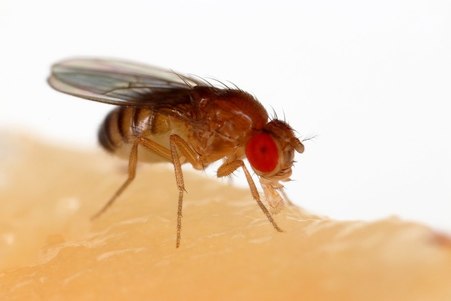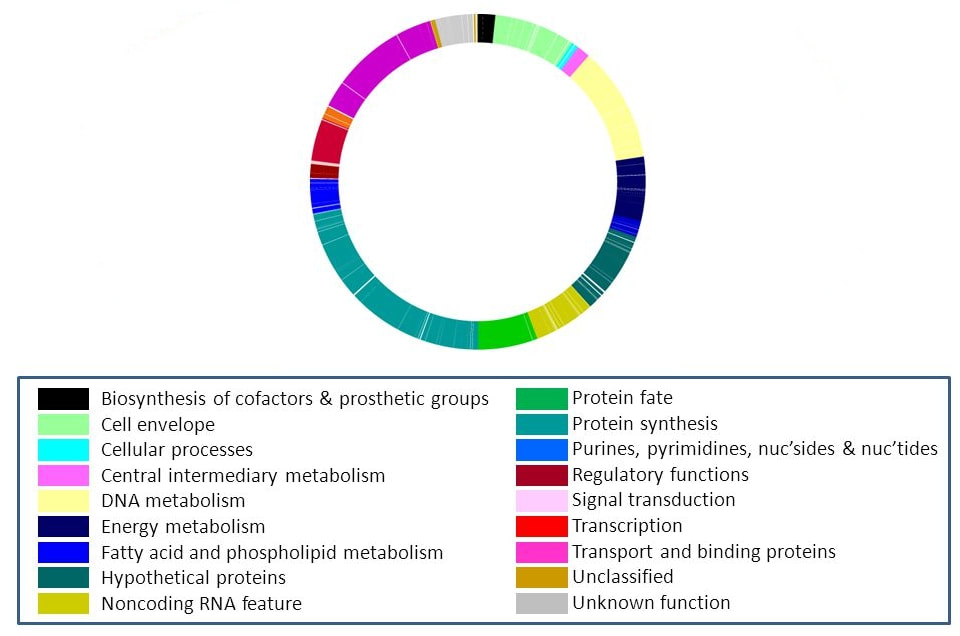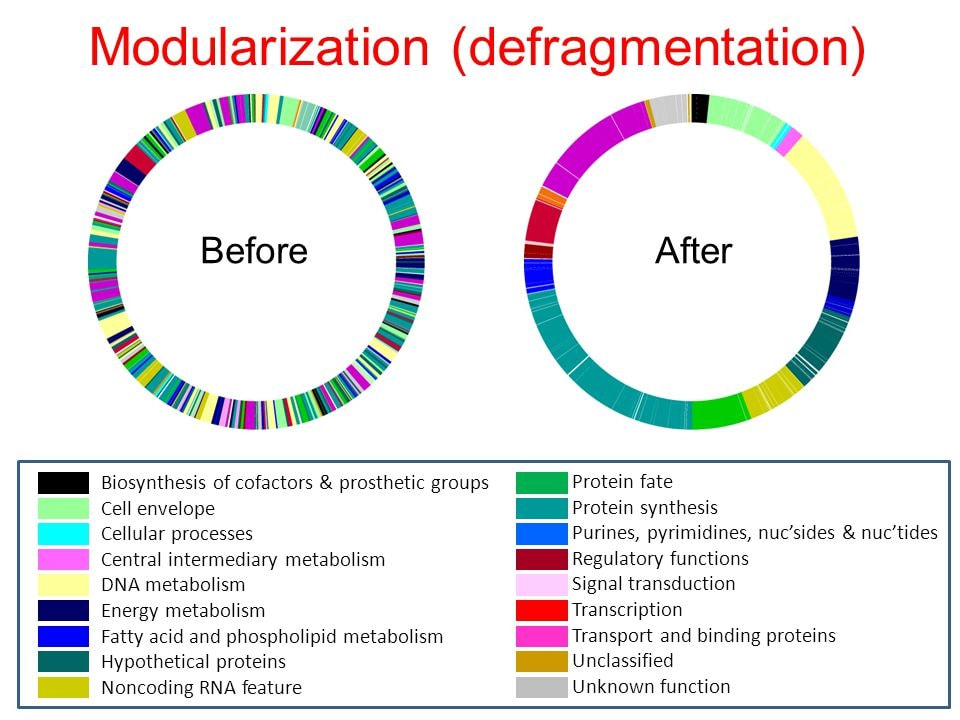 I published a post regarding the names taxonomists give to new organisms they discover and how these names can be flattering, witty, rude, insulting, or downright funny. As it turns out there is another crowd in the biological sciences that has been having a jolly good time naming things, and these are the scientists who study genes. And among these scientists, those who study fruit flies seems to have had the most fun. Now why on earth would someone want to study flies? To begin with, flies share about 60% of their DNA sequence with us, so many fly genes have equivalent human genes. Furthermore, flies have very short life cycles (which allows the study of several generations in a short time), they are easy and cheap to work with, and not only can fly mutants be studied to find out which genes are responsible for any alterations, but also the technology has been developed to modify, delete, or insert genes, and observe how these modifications change the anatomy, physiology, or behavior of the flies. All this has made fruit flies tremendously important in the study of human genetics. More than 100,000 research articles have been written by scientists employing these organisms as a model system, and a total of 6 Nobel prizes have been awarded to scientists who have used these insects to make key advances in several fields of science. So, not surprisingly, the fly researchers have discovered and named quite a few genes. But what do you name a gene when you discover it? More often than not, fruit fly scientists have selected gene names based on whatever the particular condition that the fly experienced upon mutation of the gene reminded them of. Let’s take a look at a few. There is a gene that when mutated in fruit flies leads to problems in the development of external genitalia in the male and female. What possible name would you have given this gene? Fruit fly scientists christened it the Ken and Barbie gene after the anatomically imprecise plastic dolls. There is a series of genes involved in the synthesis of steroid hormones in fruit flies. Mutations in these genes cause the fly embryos to develop scary-looking malformations in their exoskeleton. The names of the genes are: disembodied, phantom, shade, shadow, shroud, spook, and spookier. They are collective known as the Halloween genes. There are several genes that affect alcohol tolerance in fruit flies. One lab discovered a gene that when mutated made flies more resistant to alcohol (named Happyhour), a gene that when mutated made flies more sensitive to alcohol (named Cheapdate) and a gene which helps flies become tolerant to alcohol over time (named Hangover). Fruit flies have 8 photoreceptors in their compound eyes. Scientists discovered a gene that when mutated results in flies that lack the seventh photoreceptor in their eyes. Thus the gene was named Sevenless. Other genes that interacted with Sevenless were named in serial horror movie fashion: Bride of Sevenless (also known as BOSS), Daughter of Sevenless, and Son of Sevenless. My favorite fruit fly gene is one that when mutated doubles the fly’s lifespan. The gene was christened INDY, which is an acronym for “I’m Not Dead Yet”. This is in reference to the Bring Out Your Dead scene from the Monty Python and The Holy Grail movie. And the examples go on and on. What would you call a fly gene that when mutated results in flies with no hearts? Scientists named it, Tinman, after the character in The Wizard of Oz who did not have a heart. What would you call a fly gene that when mutated causes neurological degeneration with the production of holes in the brain? Swiss Cheese! What would you call genes that control the death of cells in flies? Grim and Reaper! But the name doesn’t have to be related to what a mutation does to the gene. For example, several fly genes code for proteins that are located in an area of the fly’s tissue cells called “the matrix”. Accordingly these genes were named Trynity, Nyobe, Morpheyus, Neyo (Neo), and Cypher after characters in the movie The Matrix. Despite the role of fruit flies in gene research, new genes have also been identified and named in other living things. For example, in the plant Arabidopsis thaliana there are two genes called Clark Kent and Superman that when mutated result in a plant with a large number of male parts (stamens) on their flowers. Interestingly, there is another gene called Kryptonite that when mutated causes the plants to lose their male parts and become sterile. A gene in the zebrafish that when mutated makes the fish extremely sensitive to light (so much so that light kills them) was christened “Dracula”. A gene in sheep that when mutated causes the animals to develop very prominent rear ends was named “Callipyge” which translates from Greek as “beautiful buttocks”. One final example is a gene in mice that codes for an enzyme that transfers a molecule of the sugar fucose to a protein. It was found that when this gene is mutated it causes the females to reject the sexual advances of the males. The name of the gene is the fucose mutarose gene, but it is better known by its acronym FucM ! Of course, as long as gene naming remained confined to insects or animals, all was fun and games. Unfortunately gene naming hit a snag. This was due on the one hand to how successful scientists were in finding counterparts of the genes of fruit flies and other animals in humans, and on the other hand to the fact that some of these genes were found to be associated with diseases.  Consider for example the gene Hedgehog. When this gene is mutated in flies, it causes the fly embryos to be covered with tiny spikes. The counterpart of this gene in mammals including humans was christened Sonic Hedgehog after Sega’s video game character Sonic The Hedgehog. It turned out that a mutation in the human Sonic Hedgehog genes produces a disease called Holoprosencephaly which causes brain, skull, and facial defects. So visualize the following situation: “I’m sorry, Mr. John and Jane Doe, your child was born with cranial and facial malformations, due to a mutation in Sonic Hedgehog. He may die from the disease, or if he survives, he may experience a certain degree of mental retardation or behavior problems and seizures. What is Sonic Hedgehog? Oh, it’s a gene named after a video game character. Ha, ha, ha, funny isn’t it?” As Sonic Hedgehog and other genes became linked to deadly or life-altering human diseases, clinicians became uncomfortable with explaining the inside jokes behind these playful but sometimes rude or insensitive names to patients and their families. Because of this the Human Genome Organization Gene Nomenclature Committee consulted with many scientists and renamed several of the worst offenders. So now, for example, the committee recommends that Sonic Hedgehog be known by the acronym SHH. From all the foregoing you may derive the impression that the scientists who name these genes are foolish, but nothing could be further from the truth. These funny names represent some much needed levity in what is very hard and at times very frustrating work, and these scientists have produced key advances that have increased our knowledge of how our body works and that have also saved lives. The first drug that fights cancer by targeting the Sonic Hedgehog signaling pathway in cells, Vismodegib, was approved by the FDA in 2012. So next time you hear about the Moonwalker fly (a fly that walks backward when certain neurons are activated by genetic manipulations in a manner reminiscent of Michael Jackson’s famous dance move), or the Stargazer mouse (a mouse that rears its head upwards due to a mutation in a signaling gene), think about the many nights and weekends that the scientists that worked with these critters spent in the labs and give them a smile. Image of a fruit fly by Sanjay Acharya, used here under an Attribution-ShareAlike 4.0 International (CC BY-SA 4.0). license. Image of Sonic the Hedgehog by Chris Dorward used here under an Attribution 2.0 Generic (CC BY 2.0) license.
0 Comments
For many centuries humans have wondered what makes us look the way we look. Why do people from different ethnicities still have a common recognizable body plan? What makes children look like their parents? These questions were all answered with the discovery and study of the molecule deoxyribonucleic acid, or DNA. Human DNA carries the blueprint to make a human being and keep it alive. It is because of DNA that all humans look more or less the same.
The way DNA works is that there are discrete sequences of this molecule called genes that carry the instructions to make proteins. The proteins thus made go on to make, organize, and maintain our bodies. But when scientists started sequencing the DNA molecules they found that the DNA in genes was the exception rather than the rule. Today we know that the 20,000 or so genes that human beings possess make up only 1.5% of the DNA in our bodies. The vast majority of our DNA (98.5%) is not organized into genes, and it’s not converted into proteins. What is it? The amazing answer seems to be that a good chunk of is not human! About 8% of our DNA contains sequences that bear homology to a class of existing viruses called retroviruses (one example of a retrovirus is the AIDS virus, HIV). The viruses multiply by infecting an individual’s cells and inserting themselves into the cellular DNA. The cell’s machinery then makes more copies of the virus which go on to infect other cells and eventually get transmitted to other individuals. Once the virus has incorporated into the host’s cell DNA, it’s known as an endogenous virus. If the virus infects a sperm or an egg then it can be transmitted to all the cells of the offspring, and their offspring, and so on. Along the way in this process a virus may lose infectivity for several reasons and just become one more sequence of DNA. This process seems to have happened multiple times during millions of years in the evolution of our ancestors. As a result today we have 5 times more viral DNA in our genome than we have genes coding for human proteins. However, as it turns out, this is merely the tip of the iceberg. Endogenous viruses are just one class of elements that are called “transposable elements”. There are other classes of transposable elements that, like the viral elements, can transpose from one site in the DNA to another and get copied, but unlike the viral elements, these other transposable elements cannot leave the cell. There is uncertainty regarding the origin of these other transposable elements. Scientists have proposed that some of them evolved from viruses. Other transposable elements may have originated from endogenous molecules, but then acquired a parasitic independent life of their own. Be it as it may, all in all transposable elements comprise over 45% of our DNA, a whopping 30 times more DNA than that which is contained in the genes that code for human proteins! This calculation only takes into account transposable element sequences that can be recognized as such. It is very likely that the percentage is much higher, as many ancient transposable elements sequences in our genome have degraded due to mutation and other processes and are nowadays unrecognizable. It must also be pointed out that transposable elements are not only present in humans. All forms of life have transposable elements in their DNA, ranging from maize where transposable elements comprise 70% of the genome to bees where it is only 1%. If DNA is indeed the blueprint to make and maintain a human being, what are we to make about this excess of alien DNA in our bodies? The answer can be found in evolution. Transposable elements and organisms have coevolved through millions of years in an arms race where these elements sought to transpose and make more and more copies of themselves, and organisms sought to silence them lest they transpose to the middle of a vital gene compromising its function. Although transposable elements were very active in our evolutionary past, nowadays less than 0.05% of our transposable elements are still active, but their activity is associated with genetic diseases and even cancer. However, this is half of the story. The other half is that organisms have figured out how to domesticate, modify, and co-opt transposable elements into important processes in our life cycles. For example, several genes of viral origin are used to make possible the development of the placenta. Without these genes we would not exist. Another example involves the adaptive immune system. To generate the diversity in antibodies necessary to fight off infection, immune cells employ a system derived from transposable elements. Without transposable elements forming part of our DNA we would not have a functioning adaptive immune system. We have also derived other benefits from transposable elements such as the expansion of our genomes with the creation of new genes and regulatory regions. In fact, transposable elements seem to have facilitated the very evolution of many species including ours. So these transposable elements that in the past were separate entities that pursued their own agendas within the bodies of our ancestors are now part of who we are: the aliens within are us! Creationists often claim that the complexity of life in our planet is evidence of a creator. They argue that the perfection observed in the many structures that make up the bodies of organisms can only be explained by the presence of a designer. Scientists, however, have repeatedly pointed out that the design of organisms does not have to be perfect, rather just good enough to allow them to survive and reproduce. In fact, scientists have found many flaws in the design of organisms which point to them being the result of a natural process. The critics of creation science argue that if these flawed structures had been designed by a creator, said entity would indeed be a very sloppy one. Most of the debate regarding intelligent design seems to be centered on macroscopic structures such as the eye, but what if we focus on something much smaller and more fundamental? I am talking about DNA, the molecule that carries the blueprint of life. Can we find any evidence of intelligent design in DNA? To examine this let’s look at the organization of genes. Genes are the actual segments of DNA that carry the instructions that are used to make life happen. These genes have specific functions. Some are involved in energy metabolism, others are involved in the synthesis of proteins, others are involved in the transmission of signals, and so on. So my question is: how would a creator, as opposed to a natural process, organize the genes in the DNA molecule? To use an analogy, let’s think of a person who has 500 books and wants to place them into shelves. A reasonable person would probably organize books together by categories such as detective stories, romance, science fiction, horror and so forth. This would take a certain amount of effort and discernment. On the other hand, a sloppy or lazy person, or a person employing a random system to distribute books would probably place them in the shelves with no discernible order. Does the DNA of even a single living thing display evidence of intelligence being involved in the organization of genes in their DNA molecules? Well, you will be surprised to know that I have found one such example! In the figure below I present the DNA of a species of bacteria (this particular bacterial DNA is circular). As you can see, as in the above analogy of the books in the shelves, the genes are neatly organized into categories. All the genes involved in DNA metabolism (in yellow) are in one area of the DNA molecule, whereas all the genes involved in making transport and binding proteins (in purple) are in another area, and the same is true for genes with other functions and even genes that we have not yet classified or whose function is unknown to us! So there can be no question about it. Here is irrefutable evidence of intelligent design. No natural process can account for the existence of this molecule. This DNA was designed by an entity with a consciousness (and a very well developed sense of tidiness). When it comes to the process that made the DNA of this bacterial species come into being, creationists are 100% right! Unfortunately the designer of this bacterial DNA molecule is not God but a scientist named Craigh Venter. Dr. Venter and his team were trying to design a minimal bacterial genome to study the functions of genes that are required for life, and they wanted all genes organized in discrete units that they could move around. So (much in the same way that we defragment a computer to organize all the information that ends up scattered over its memory banks) they proceeded to defragment the bacterial DNA generating the one presented above. But, how did the initial bacterial DNA look? See the original figure below. The original DNA is in the left hand side. The seemingly random scattershot organization of its genes is not unique to this bacterial DNA. All DNAs from all species of living things sequenced so far show this lack of organization of the genetic information into any overall cohesive pattern. So now you know how real intelligent design looks: it looks like nothing that can be found in the natural world. Illustrations taken from the presentation From Synthetic Life to Human Longevity by Dr. Craig Venter's at the Inaugural Scientific Symposium of the Center for Systems Biology Dresden (CSBD) on June 1st, 2017. The use of these illustrations is covered under the United States Copyright Law of Fair Use (Title 17 of the United States Code, Section 107). |
Details
Categories
All
Archives
June 2024
|


 RSS Feed
RSS Feed